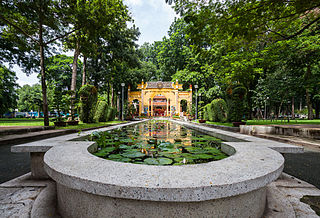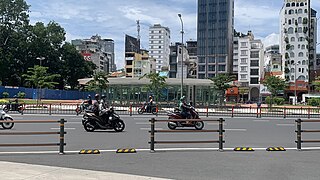
Transportation in Vietnam is improving rapidly in terms of both quantity and quality. Road traffic is growing rapidly but the major roads are dangerous and slow to travel on due to outdated design and an inappropriate traffic mix. In recent years, the construction of expressways has accelerated. Air travel is also important for long-distance travel. Metro systems are under construction in the two metropolises of Hanoi and Ho Chi Minh City.

Ho Chi Minh City, also known as Saigon, is the most populous city in Vietnam, with a population of around 10 million in 2023. The city's geography is defined by rivers and canals, of which the largest Saigon River is named after. As a municipality, Ho Chi Minh City consists of 16 urban districts, five rural districts, and one municipal city (sub-city). As the largest financial centre in Vietnam, Ho Chi Minh City has the highest gross regional domestic product out of all Vietnam provinces and municipalities, contributing around a quarter of the country's total GDP. Ho Chi Minh City's metropolitan area is ASEAN's 6th largest economy, also the biggest outside an ASEAN country capital.

The Ho Chi Minh City Metro is a planned rapid transit system that will serve Ho Chi Minh City in Vietnam.

Long Thanh International Airport is an international airport under construction in Long Thành district, Đồng Nai province, Vietnam, approximately 40 km (25 mi) east of Ho Chi Minh City. It will be the second airport to serve the Ho Chi Minh City metropolitan area, after the existing Tan Son Nhat International Airport. It is being built as an alternative to the existing airport, in order to relieve its increasing traffic, demand and congestion, as it could not be further expanded due to urban growth around it. The Government of Vietnam approved its construction on 4 January 2021. Construction began the next day on 5 January, and its first phase was scheduled to be finished by September 2025, but now it is expected to be finished by the first half of 2026. The airport will serve over 100 million passengers and five million tonnes of cargo annually when built to the maximum designed capacity, making it the largest airport in Vietnam, Southeast Asia and one of the largest in the world. The project is the most expensive infrastructure project in Vietnam's history. Once open, both airports will operate together. The national carrier, Vietnam Airlines, is suggested by the project consultants as the only Vietnamese carrier to operate flights from Long Thanh, while other airlines will wholly stay at the existing airport.
Nigerians in Vietnam are mostly expatriates from Nigeria residing in Vietnam for business or economic purposes. They are part of a new wave of Nigerian emigrants going to non-traditional migration destinations such as Ethiopia, Ghana, and Mozambique rather than traditional favorites like Libya, the United Kingdom, or the United States. They refer to poor economic conditions in their homeland, including lack of electricity and public safety, as their primary motivations for emigration.

The manufacture and adoption of electric vehicles have been given preferential treatment by the Vietnamese government in order to reduce vehicle emission pollution. From March 1, 2022, battery powered cars will be exempt from registration fees for 3 years, along with subject to reduced excise taxes.

Tao Dan Park is an urban park in District 1, Ho Chi Minh City, Vietnam behind the Independence Palace. It is of the largest parks in the city, covering 10 hectares. Part of the park will be used for the Ho Chi Minh City Metro Line 2's Tao Dan Station. The park formerly hosted a bird park that attracted songbird owners.

The Ba Son Bridge, originally known as Thu Thiem 2 Bridge, is a 6-lane bridge in Ho Chi Minh City, Vietnam, opened in 2022. The bridge crosses the Saigon River to link District 1 and Thu Duc City.

Line 1 is a rapid transit line of the Ho Chi Minh City Metro, Vietnam. Line 1 is the city's first metro line, connecting District 1 and Thu Duc City. The line began construction in 2012, initially scheduled for completion in 2018. The project's completion date has been delayed to the end of 2024. Ticket prices will range from VND9,000-23,000 ($0.39-1) per trip.

Bến Thành Station is a future underground Ho Chi Minh City Metro interchange station on the future Line 1, Line 2, Line 3A, and Line 4A. Located in front of Bến Thành Market, the station will serve as the central metro station in Ho Chi Minh City, Vietnam.

Opera House Station is a future underground Ho Chi Minh City Metro station on Line 1. Built in front of the Municipal Theatre of Ho Chi Minh City, underneath Lê Lợi Boulevard, the station opened to public viewing in April 2020. It is expected to be completed in by the end of 2023 before public operations begin in early 2024.
Long Binh Depot is a train depot located in Thu Duc, Ho Chi Minh City, Vietnam. The 20 ha depot serves as the control center and maintenance yard for Line 1 of the Ho Chi Minh City Metro.
Ba Son Station is a future underground Ho Chi Minh City Metro station on Line 1. Located in District 1 at the site of the former Ba Son Shipyard, the station is planned to open in 2024.
An Phú is a ward (phường) of Thu Duc in Ho Chi Minh City, Vietnam.

National University Station is a future elevated Ho Chi Minh City Metro station on Line 1. Located opposite Suoi Tien Amusement Park in Thu Duc City, near VNU-HCM, the station is planned to open in Q4 2024, with a limited opening period starting in July.

The Nhieu Loc–Thi Nghe Channel is a waterway in Ho Chi Minh City, Vietnam. The 9 km long canal passes through Districts 1, 3, Phu Nhuan, Tan Binh and Binh Thanh and flows into the Saigon River.
Tao Đàn Station is a future underground Ho Chi Minh City Metro station on Line 2. The station will be located under Tao Đàn Park.
Annette Kim is an American academic and urban planner. Kim is an associate professor at the University of Southern California Price School of Public Policy, and Director of the Spatial Analysis Lab (SLAB). Kim previously served as associate professor at MIT's Department of Urban Studies and Planning.
Bàn Cờ Market is a market in District 3, Ho Chi Minh City selling a variety of produce, meat, and prepared foods. The market is located off Ban Co Street between Nguyen Dinh Chieu and Dien Bien Phu, near the Nguyen Thien Thuat apartment buildings. Bàn Cờ Market comprises one main laneway and several branching off, its name "Bàn Cờ" reflects the market's resemblance to a chessboard in layout. The market is popular for its Vietnamese street food, including banh xeo, bot chien, and banh khot.











